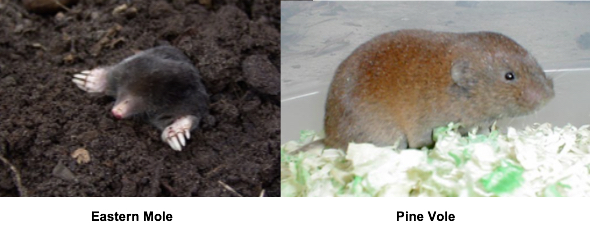Moles and Voles – How to Identify and Control Them in Your Home Landscape
go.ncsu.edu/readext?570809
en Español / em Português
El inglés es el idioma de control de esta página. En la medida en que haya algún conflicto entre la traducción al inglés y la traducción, el inglés prevalece.
Al hacer clic en el enlace de traducción se activa un servicio de traducción gratuito para convertir la página al español. Al igual que con cualquier traducción por Internet, la conversión no es sensible al contexto y puede que no traduzca el texto en su significado original. NC State Extension no garantiza la exactitud del texto traducido. Por favor, tenga en cuenta que algunas aplicaciones y/o servicios pueden no funcionar como se espera cuando se traducen.
Português
Inglês é o idioma de controle desta página. Na medida que haja algum conflito entre o texto original em Inglês e a tradução, o Inglês prevalece.
Ao clicar no link de tradução, um serviço gratuito de tradução será ativado para converter a página para o Português. Como em qualquer tradução pela internet, a conversão não é sensivel ao contexto e pode não ocorrer a tradução para o significado orginal. O serviço de Extensão da Carolina do Norte (NC State Extension) não garante a exatidão do texto traduzido. Por favor, observe que algumas funções ou serviços podem não funcionar como esperado após a tradução.
English
English is the controlling language of this page. To the extent there is any conflict between the English text and the translation, English controls.
Clicking on the translation link activates a free translation service to convert the page to Spanish. As with any Internet translation, the conversion is not context-sensitive and may not translate the text to its original meaning. NC State Extension does not guarantee the accuracy of the translated text. Please note that some applications and/or services may not function as expected when translated.
Collapse ▲ There are certain things when thought of and spoken that just seem to go together; peas & carrots, peanut butter & jelly, stars & stripes, Romeo & Juliet, Batman & Robin, Bevis & Butthead, and moles & voles. Moles and voles can be as annoying and destructive to your home landscape as the last aforementioned in the list before moles & voles. Mole and vole control questions are one of the most frequently asked at the N.C. Cooperative Extension of Johnston County office and our Master Gardener℠ volunteer Mobile Plant Clinics.
There are certain things when thought of and spoken that just seem to go together; peas & carrots, peanut butter & jelly, stars & stripes, Romeo & Juliet, Batman & Robin, Bevis & Butthead, and moles & voles. Moles and voles can be as annoying and destructive to your home landscape as the last aforementioned in the list before moles & voles. Mole and vole control questions are one of the most frequently asked at the N.C. Cooperative Extension of Johnston County office and our Master Gardener℠ volunteer Mobile Plant Clinics.
Many people are confused about their differences and often moles are incorrectly blamed for vole damage. About the only thing they have in common is that their names rhyme and they both dig underground. While these two garden pests cause anxiety and an immediate desire to gain control, knowing their differences can help determine the best control methods. Your first step is to distinguish which pest you have by observing the type of damage they do. It’s possible to have both moles and voles at the same time causing damage to your property.




